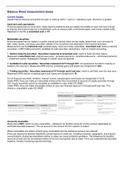Balance Sheet measurement bases
Current Assets
Assets that will likely be converted into cash or used up within 1 year or 1 operating cycle, whichever is greater.
Cash and cash equivalents
Financial assets that are short-term, highly liquid investments that are readily convertible to cash and near enough
to maturity that interest rate risk is insignificant, such as treasury bills, commercial paper, and money market funds.
Reported on the BS at amortized cost or FV.
Marketable securities
Financial assets that are traded in a public market and whose value can be readily determined, such as treasury
bills, notes, bonds, and equity securities. Details of the investment are disclosed in the financial footnotes.
Measurement can be historical cost (unlisted equity, loans and notes receivable), amortized cost (held-to-maturity
securities), or FV (trading securities, available-for-sale securities, derivatives)/ mark-to-market accounting.
1. Held-to-maturity securities / Securities measured at amortized cost: intent to hold until they mature.
Measured at amortized cost, original issue price – principal payments + amortized discounts – amortized premiums
– impairment losses. Subsequent changes in market value are ignored.
2. Available-for-sale securities / Securities measured at FV though OCI: not expected to be held to maturity or
traded in the near term. Measured at FV and the unrealized gains and losses are recognized in OCI.
3. Trading securities / Securities measured at FV through profit and loss: intent to sell them over the near term.
Measured at FV and the unrealized gains and losses are recognized in IS.
For all financial securities, dividend, interest income, realized gains and losses are recognized in the IS.
Under IFRS, firms can make an irrevocable choice at the time of purchase to account for equity securities through
OCI. Equity securities cannot be classified as available-for-sale under US GAAP.
Under IFRS, firms can make irrevocable choice to carry any financial asset at FV through profit and loss. This
choice is unavailable under US GAAP.
Accounts receivable
Measured at NRV, which is gross receivables – allowance for doubtful accounts (contra account depending on
estimated bad debt expense). The net amount is the amount the firm expects to collect.
When receivables are written off both gross receivables and the allowance account are reduced.
Firms are required to disclose significant concentrations of credit risk, including customer, geographic, and industry
concentrations. Analyzing receivables relative to sales can reveal collection problems. The allowance for doubtful
accounts should also be considered relative to the level and growth rate of sales. Firms can underestimate bad debt
expense, thereby increasing reported earnings.
, Inventories
Goods held for sale to customers or used in manufacture of goods to be sold. Manufacturing firms separately report
inventories of raw materials, work-in-process, and finished goods.
Product costs included in inventory: Purchase cost, conversion costs, and other costs necessary to bring the
inventory to its present location and condition.
Period cost expensed: Abnormal waste, storage costs (unless part of production), administrative overhead, and
selling costs.
Measure costs:
Standard costing and the retail method are used by some firms to measure inventory costs. Standard costing,
often used by manufacturing firms, involves assigning predetermined amounts of materials, labor, and overhead to
goods produced. Firms that use the retail method measure inventory at retail prices and then subtract gross profit
in order to determine cost.
Assign costs:
Using different cost flow methods, firms assign inventory costs to the IS with COGS.
Inventories are reported at the lower of cost or NRV under IFRS, and under US GAAP for companies that use
inventory cost methods other than LIFO or retail. NRV is equal to the selling price – any completion costs and
disposal (selling) costs.
Under US GAAP, companies using LIFO or the retail method report inventories at the lower of cost or market.
Market is NRV – normal profit margin < replacement cost < NRV.
If NRV (IFRS) or market (US GAAP) is less than the inventory's carrying value, the inventory is written down and a
loss is recognized in the IS. Write-down is accomplished with valuation allowance (contra-asset account).
IFRS: if there is a subsequent recovery in value, the inventory can be written back up, but only until the original
NRV. The carrying value cannot exceed original cost.
US GAAP: No write-up is allowed; the firm simply reports greater profit when the inventory is sold.
In certain industries, reporting inventory above historical cost is permitted under IFRS and US GAAP. This
exception applies primarily to producers and dealers of commodity-like products, such as precious metals,
agricultural. Inventory is reported at NRV and any unrealized gains and losses from changing market prices are
recognized in the IS.
Changing inventory cost flow method is applied retrospectively and the cumulative effect of the change is reported
as an adjustment to the beginning retained earnings. IFRS: demonstrate change will provide reliable and more
relevant information. US GAAP: explain why change is preferable.
Exception is changing to LIFO as change is applied prospectively.
Other current assets
Other current assets include amounts that may not be material if shown separately; thus, the items are combined
into a single amount.
Such as, prepaid expenses, which are operating costs that have been paid in advance. As the costs are actually
incurred, an expense is recognized in IS and prepaid expenses decrease.
Noncurrent assets
Property, plant, and equipment
Tangible assets used in the production of goods and services, such as land and buildings, machinery and
equipment, furniture, and natural resources. An expenditure that is expected to provide a future economic benefit
over multiple periods is capitalized, however, if future economic benefit is unlikely of uncertain, the expenditure is
expensed.
Once capitalized, subsequent related expenditures that provide more future economic (e.g. rebuilding the asset) are
also capitalized. Expenditures that merely sustain the usefulness of the asset (e.g. regular maintenance, training
cost, repair) are expensed when incurred.
IFRS: measured with cost model or revaluation model.





